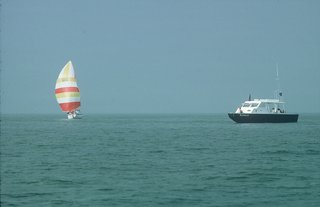
|
FBYC History.... Jere DennisonSome may wonder why we have named the new race committee launch Wildcat II. Besides being a really cool name, it was derived from the original Wildcat that served FBYC as its primary committee boat from 1975 to 1980 when she was replaced by the first Mr. Roberts. But I am getting ahead of myself From at least the early 1950s when the club relocated from Urbanna, our committee boat was the Black Cat, a WWII vintage surplus vessel converted to civilian use and chartered from Gene Ruark. Gene berthed her at his nearby marina and maintained her unpredictable mechanical systems. But she was a tough old gal, for she kept our race committees afloat for about 25 years. Thanks to Bob Graham, we have located a picture of this less than photogenic vessel on station in the early 1970s. In spite of her eccentric appearance, she never sank, at least on the racecourse, and always brought our committee members home safely. However, in early 1975, our Board began to have real concerns about the age and continued serviceability of the venerable Black Cat. Some members felt that the club should purchase a new committee boat; others supported the retention of Black Cat until proven absolutely unsafe. The controversy raged. It wasnt long before Gene Ruark acted preemptively to protect his charter arrangement with the club. An opportunity presented itself in the form of a 27-foot Broadwater Express Cruiser, a modest pleasure boat easily convertible to yacht club duties. A special committee was appointed by the Board to assist Gene in the selection of a new committee boat and confirmed his choice of the Broadwater. The July, 1975 Log stated that the new boat has a single inboard engine with power to spare, overnight accommodations for four, well equipped galley facilities, and a spacious cockpit for race committee work. This red-hulled vessel was rechristened Wildcat, probably in homage to the memory of her black-hulled predecessor, a floating FBYC icon for so many years. However, the choice of the new boat was itself not without controversy. It seems that more than one of the plywood-hull Broadwaters had experienced disintegrating bottoms in turbulent waters. Had we jumped from the frying pan into the fire? Built in Maryland, the factory received a bad load of plywood in 1970 which led to lawsuits and some extremely negative press when boats sank on the Chesapeake. Doing his survey carefully, Gene concluded that the Wildcat was not constructed with the bad batch of wood and was able to purchase a sound boat for a pittance. Unfortunately, I have not been able to find any pictures of the Wildcat in honor of which we have named our new RC launch. If any turn up, please let me know. |